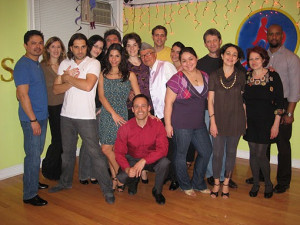
Argentine tango classes in NYC
Argentine tango and ballroom tango. What’s the difference? The way the dances look and the music they are danced to are the two major differences. Ballroom tango has a very pronounce, prominent and steady tempo. Almost like a ticking clock. It sounds a bit like paso doble. Argentine tango music is very varied. Some of it, like music from Biagi or Canero has a strong, easy to hear base. Some music may have a strong melody and a very weak base. Milonga Triste by Hugo Diaz is an example. There’s Argentine tango music that has both: alternating powerful beat, and then the base will totally drop out, and you have only melody. Osvaldo Pugliese music is often like this.
Argentine tango has no basic step. It is a totally improvisational dance. Ballroom tango has an 8 count basic which is slow, slow, quick, quick, slow. Most patterns are done using this 8 count basic. Ballroom tango really moves around the room. You are not in one spot for very long. In Argentine tango, you may stay in the same spot for quite a long time doing gauchos, boleos and embellishments. Argentine tango is often danced in close embrace, or salon style. Ballroom tango isn’t. It has a very formal, ballroom look to it. In ballroom tango there are more broad movements with the upper body: sways and dips. There are also more staccato movements like head snaps. You won’t see these types of movements in Argentine tango. Most of the movements are below the waist.
At the advanced level, the patterns and steps in Argentine tango are way more complicated and difficult to do. Ballroom tango does not have volcadas, calesitas, planeos, and barridas or the cross. These are steps that any advanced Argentine tango dancer and many intermediate dancers will know. Ballroom tango is almost always danced in parallel foot system. While Argentine tango is both parallel system and cross foot system.
The dances also have a different feel to them. When dancing ballroom tango the movements are strong, staccato and floor sweeping. You are more with the base. When dancing Argentine tango, you are more with the melody. Listing to any accents in the music and trying to hit them with your movements.

